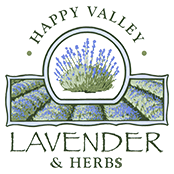|

August 2004
Herbal Nutrition
Feeding your Lavender & herbs
This is nutrition for all those herbs you grow to nurture you in so many ways! Yes~ I do fertilize my Herbs including my Lavenders. And Yes, Herbs can grow in poor soil and are drought tolerant ... once established. Does that sound contrary to you? Essentially it is the bottom line of keeping your Herbs alive ~ just. I want more from my Herbs. I want them to be vibrant, more than just surviving ~ I want them to almost "glow in the dark" with Health, Taste, and Fragrance!
When working with small seedlings at transplant time, I place a teaspoon of an organic alfalfa base dry fertilizer in each 4" pot. You can purchase this from Integrity sales on Keating X Road. (Certified Organic Blend) I fill the pot half way with a light potting soil, spoon in the fertilizer, stir lightly, top with more potting soil, then water. Make a planting hole, pop in the baby and nestle in firmly. When I see evidence of active growth; more new leaves usually, I feed with a foliar spray of diluted fish fertilizer, manure tea or a commercial (organic) product like Raingrow 4.2.3. Add this extra form of fertilizing to your continuing care for any of your annual herbs who must perform quickly for a better harvest. I am thinking of ones like Summer Savory, Sweet Marjoram and especially dear Basil.
Stage 2 is when I plant these 4" potted Herbs out into "the real world": a display garden, a production area or my veggie patch. I check that their roots extend to the bottom of the pot, with a good network of root threads. I now place a tablespoon of the same powdered fertilizer in the planting hole, usually "puddling" with water before slipping the maturing Herb into the ground. I use the same practice when potting up a 4" potted Herb to a gallon, the only difference being adding a richer soil blend in the bottom half of the pot by amending the potting mix with manure and compost. I use straight potting soil to top it up as it is sterile and keeps weeding to a minimum compared to pure compost.
When I plant out gallon sized Herbs, usually perennials ~ I use ½ cup to a full cup measure in the planting hole. Examples would be Rosemary (½ c), Lavender (½ cup) or Roses (1 full cup). Again mix the fertilizer with the existing soil, pre-water the hole ("puddling"), plant ~ re-water. This extra watering is a must if planting in June, July or August to make sure the soil is moist deeper than surface watering will do. As much as I maintain my soil fertility in general in display gardens and such, I want extra nutrients to be specific to where I am planting and not broadcast to grow healthier weeds. (Weeds: I have enough of those already!)
For trees and shrubs, I prepare a 2 foot to 3 foot diameter planting hole with compost and manure and up to 2 cups of fertilizer to get them off to a good start.
For gallon pots sitting on a holding tarp, waiting for a buyer; once or twice a month I will supplement with a foliar feed as daily watering can leech out the goodness as fast as I add it.
For the display garden permanent "residents", it now becomes seasonal maintenance with a spring and fall clean up and possible top dressing.
Sweet Basil is the only one in the veggie patch to get any extra attention for side dressing or foliar feed. This year I tried adding granite dust for its extra mineral supplements to the normal basic fertilizer blend. I want Basil thigh high!
The field Lavenders make do with the extra attention to the field soil before planting and their transplant "dosage". My blocks of Lavender in a field situation last 10-13 years before I tear them out and start from scratch again.
Mother Nature takes care of the rest but I do believe in giving them a healthy thriving start.
With the recent drought style summers, and this year as early as Spring, all my display gardens and 4 out of 5 Lavender blocks are now on micro-drip to try and put water only where and when needed. You will have noticed by now the plant clocks in general are on "fast forward". As I write in mid June, my Lavender crop is only days away from harvesting and it is not Solstice yet ~ Harvest a good month ahead. Our dry, extra warm & sunny March and April have triggered many many trees, shrubs, flowers and plants in general to quickly mature and even set seed ~ NOW! My first lettuce, spinach and coriander all tried to flower and set seed at 2" high?
Here is the bonus to all this seemingly craziness as we struggle to be flexible and "catch up": you will get a decent second crop of bloom on your Angustifolia Lavenders in mid August or so.
Try to sneak in a series of Lavender cuttings in early August as September could bring earlier winter-like conditions before the next new growth on the Lavenders.
Lavender cuttings are not that difficult, yet need daily attention for success. They also guarantee a "clone" as good as the mother plant you choose as it will be an exact duplicate in colour, shape and fragrance. "Choose wisely", mark your favourite Lavenders now!
Cut a non-flowering tip 3 inches long; gently remove the bottom pair of leaves along the stem. Then gently insert half the depth of the stem in a prepared tray of moistened light potting mix. (Add extra fine perlite or sand to keep the soil well drained and not soggy.) Place in partial shade, water daily and they will generally root in 6 to 8 weeks. Be mean here ~ no fertilizer, no foliar feed. You want them to reach out for water by making new roots. I have been experimenting with a liquid bone meal product from Raingrow Bloom-A-Long, adding it to the watering can. (So far Pineapple Sage loved it, Lemon Verbena so-so, Mint hated it.) Seed propagation in the Spring is great for sheer numbers; late Summer cuttings guarantee plant consistency. Also, for hybrid Lavandins for example ~ it is the only way you can propagate more stock ...
Well now ~ this was Fertilizer 101 and Propagation 201!
Enjoy Summer day by day as Mother Nature plays the weather like an orchestra! Eat lots of luscious Basil and drink refreshing Lavender Earl Grey Tea!
Happy Summer ~ LYNDA
Originally published in the August 2004 edition of the Metchosin Muse
Printable Version 
|

